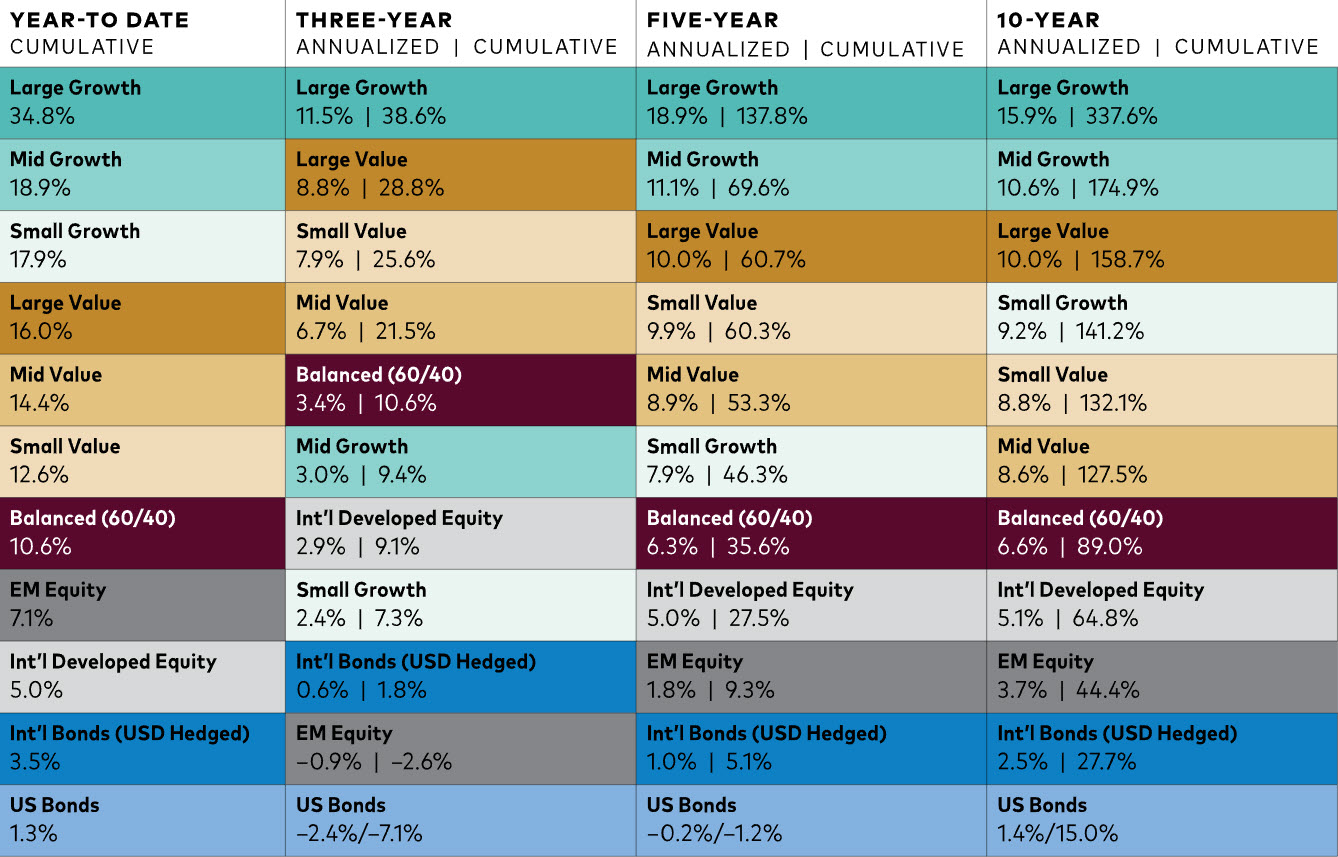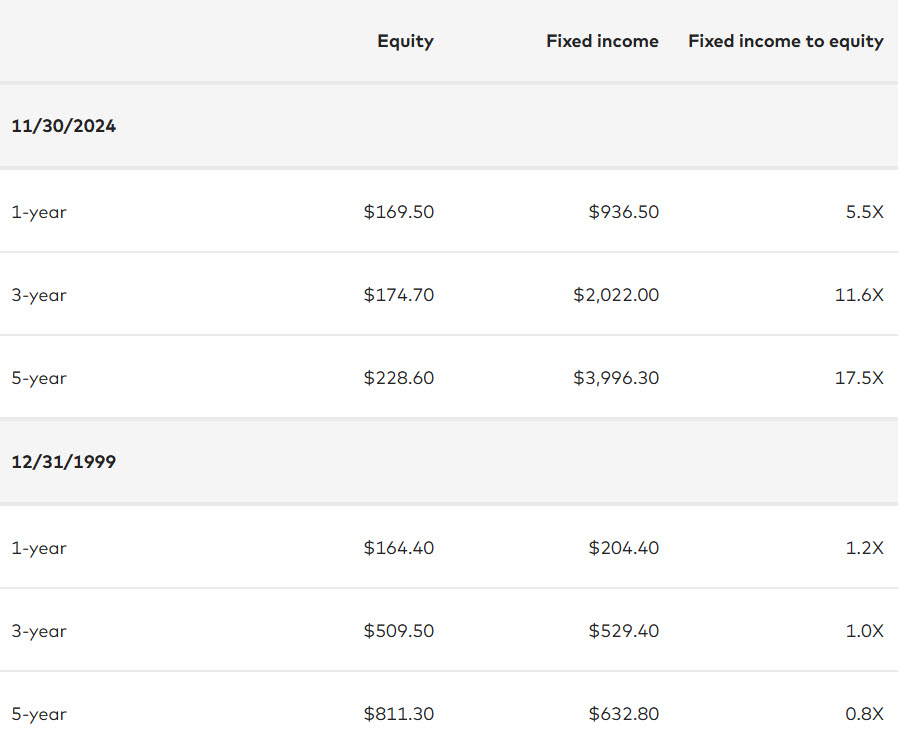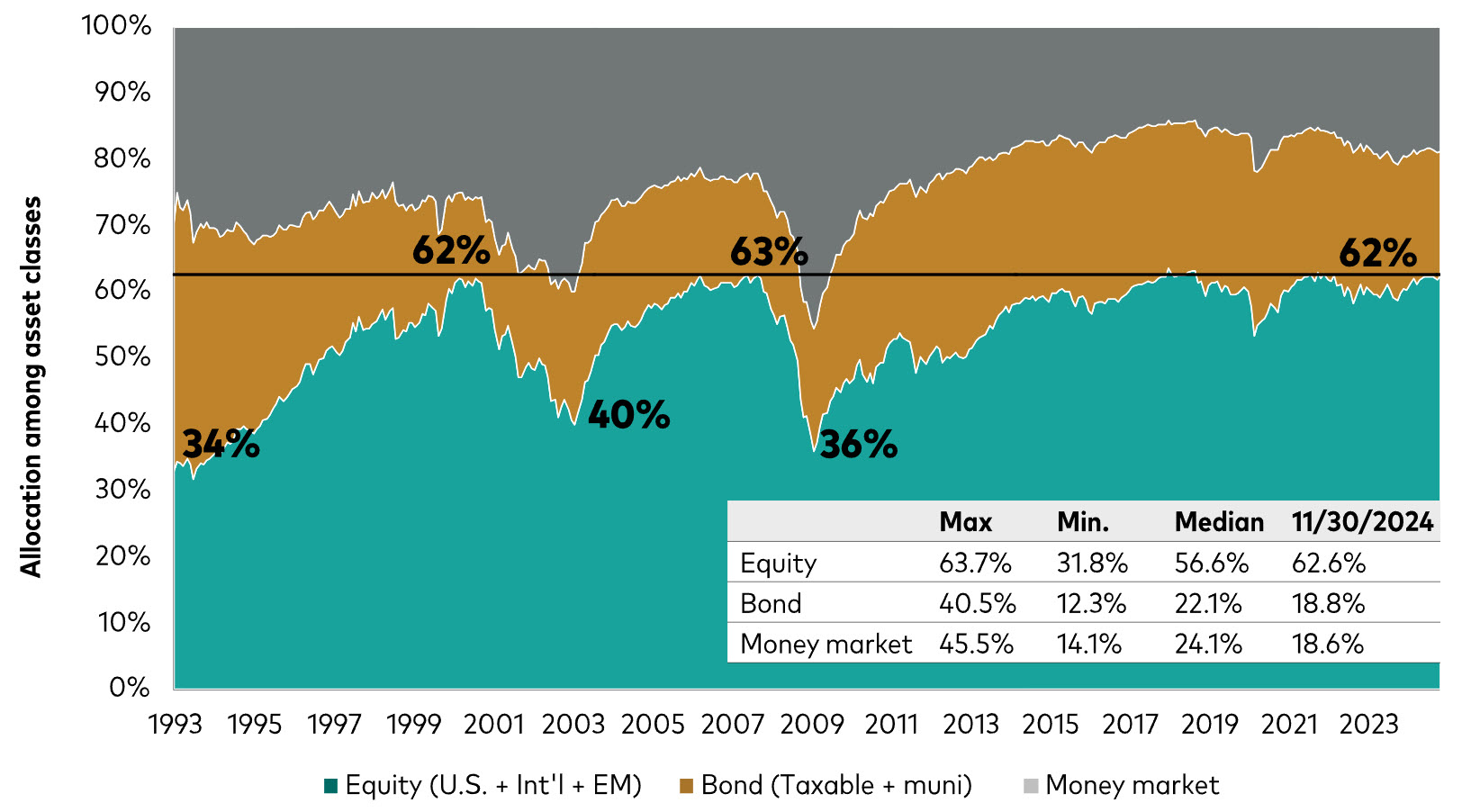Este artículo está disponible sólo en inglés.
At the start of the year, it would have been easy for advisors to justify lowering their equity allocations, especially to U.S. equities, stocks in the Magnificent 8 (Mag 8),1 and/or large-cap growth stocks amidst low U.S. equity market predictions, high relative valuations, and higher bond yields. These conditions led analysts and financial experts alike to sound a cautionary tale, with headlines from major financial publications echoing this sentiment:
- Bloomberg: "2024 Market Outlook: Caution Prevails Amid Uncertainty."
- The Wall Street Journal: "S&P 500 Faces Headwinds in 2024."
- CNBC: "Economic Indicators Suggest a Rocky Start to 2024 for Investors."
Despite the initial concerns and negative sentiment surrounding the U.S. equity markets, the market defied expectations, setting new all-time highs on 57 different days—ranking as the fifth most in history. This performance is on track to deliver an annual return of approximately 24% as of December 27 (Figure 1a). The incredibly strong equity returns, especially in the face of such dire predictions early in the year, underscore the importance of ignoring market noise and sticking to your investment plan. As Vanguard founder Jack C. Bogle famously advised, “press on regardless and stay the course!”
This year’s strong U.S. equity returns follow the robust performance of U.S. equities in 2023, resulting in two consecutive years with returns exceeding 20%. In fact, the U.S. equity market has provided returns exceeding 20% in five of the last six years, with the exception being 2022, when it was down 19%. As we continue to observe, equity returns are rarely as expected and seldom near their long-term averages. Instead, they exhibit a wide distribution, making the ability to tune out the noise a true superpower for investing success.
While U.S. equity markets produced strong returns, non-U.S. equity markets continued to underperform, with the total international equity market as of December 27 up approximately 5%. U.S. bond markets, as measured by the Bloomberg U.S. Aggregate Bond Index, had a positive yet more muted return of approximately 1% (Figure 1b). Balanced allocations, such as a 60% U.S. stock /40% U.S. bond portfolio, provided a return of approximately 14% (Figure 1c). The strong performance of both U.S. equity and balanced portfolios in 2024 once again highlights the importance of tuning out the noise and maintaining a long-term investment strategy.
Figure 1a. Distribution of annual stock returns from 1928 to 2024

Figure 1b. Distribution of annual bond returns from 1928 to 2024

Figure 1c. Distribution of annual 60% stock and 40% bond returns from 1928 to 2024

Notes: Figures 1a. through 1c. show the cumulative performance from January through December each calendar year going back to 1928. Data for 2024 performance is through December20, 2024.
Sources: Investment Advisory Research Center analysis using data from Morningstar, Inc. Figures 1a. through 1c.: Stocks: S&P 90 Index from 1928 through March 3, 1957; S&P 500 Index from March 4, 1957, through 1970; Wilshire 5000 from 1971 through April 22, 2005; MSCI US Broad Market Index from April 23, 2005, through June 2, 2013; and CRSP US Total Market Index thereafter. Bonds: IA SBBI U.S. Intermediate-Term Government Bond Index from 1928 through 1972; Bloomberg U.S. Government/Credit Intermediate-Term Index from 1973 through 1975; and Bloomberg U.S. Aggregate Bond Index thereafter. 60-40: Simulated portfolio with 60% allocated to stocks and 40% allocated to bonds.
Past performance is not a guarantee of future returns. The performance of an index is not an exact representation of any particular investment, as you cannot invest directly in an index.
In investing, it’s common to hear warnings of bubbles and impending bear markets. In our prior market commentaries, we sought to raise advisor awareness of this through our Three B Mental Model, as some businesses are incentivized to grab your attention by capitalizing on known investor fears and loss-aversion tendencies. Together, these can lead to short-term actions that go against long-term objectives.
Headlines over the past decade have repeatedly suggested that the Mag 8—and large-cap growth stocks more broadly—are overvalued (or even a bubble) and likely due for a pullback. As a result, the temptation to underweight these companies has been high, which is understandable given their relative valuations. But it is important to remember that the markets are forward-looking and that securities trade in deep auction markets dominated by large, sophisticated investors who incorporate all relevant factors into their price discovery process, not just relative valuations. Once again, the markets proved to be more accurate in predicting the future compared with the headlines and commonly used indicators.
While outperforming the markets is certainly possible, it's far more challenging than most believe. For example, as shown in Figure 2, despite the overwhelming negative sentiment for U.S. large-cap growth stocks, they have continued to outperform the other major public asset classes, not only in 2024 but also over the past three, five, and 10 years. Missing out on these exponentially higher returns—entirely or in part—would have materially harmed client and practice outcomes. Figure 2 also highlights the wide dispersion in returns among sub-asset classes and how the balanced category has returns closer to the center of the return distribution range, as expected and by design, reinforcing the importance of broad diversification.
Figure 2. Trailing market returns for selected indexes

Sources: Investment Advisory Research Center analysis using data from Morningstar, Inc. Large Growth: CRSP US Large Cap Growth Index; Large Value: CRSP US Large Cap Value Index; Mid Growth: CRSP US Mid Cap Growth Index; Mid Value: CRSP US Mid Cap Value Index; Small Growth: CRSP US Small Cap Growth Index; Small Value: CRSP US Small Cap Value Index; International Developed Equity: MSCI World ex USA Index (in USD); Emerging Market Equity: MSCI Emerging Markets Index (in USD); U.S. Bonds: Bloomberg U.S. Aggregate Index (Float Adjusted); International Bonds (USD Hedged.): Bloomberg Global Aggregate ex USD Index (USD Hedged); Balanced (60/40): 36% CRSP US Total Stock Market Index, 24% MSCI All Country World Index IMI (in USD), 28% Bloomberg U.S. Aggregate Bond Index (Float Adjusted), and 12% Bloomberg Global Aggregate ex USD Index (USD Hedged).
Past performance is not a guarantee of future returns. The performance of an index is not an exact representation of any particular investment, as you cannot invest directly in an index.
Advisors have successfully helped clients “stay the course”
Despite very strong, almost historic relative outperformance of equities to bonds over the last one, three, five, and 10 years, Vanguard’s Risk Appetite Speedometers show that equity allocations have not substantially drifted up (as has commonly occurred in the past) but have largely stayed the course as seen in Figure 4. Our research, which analyzes mutual fund and ETF cash flows within the context of relative investment performance and aggregate industry asset allocations, reveals that fund allocators remained disciplined and, for the most part, rebalanced their portfolios. This behavior is notably different from previous long and strong equity bull markets and aligns with our Advisor's Alpha® research.
For example, U.S. equity market returns exceeded 20% in each year from 1995 to 1999 and the aggregate industry equity allocation drifted from 38% at the beginning of 1995 to 64% by the end of 1999 (Figure 4). If investors and their advisors were rebalancing during this period, you would expect to see materially more cash flow into fixed income.
2024 saw unprecedented cash flows into fixed income
While 1999 and 2024 share similar U.S. equity market returns when compared with bonds, the relative cash flows during each period were materially different (Figure 3). In 1999 and the years leading up to it, cash flows into equities and fixed income were relatively balanced, as indicated by a fixed income-to-equity ratio of approximately 1X. However, in 2024 and the preceding years, there has been an unprecedented shift, with cash flows into fixed income ranging from five to 17 times those into equities. This type of contrarian, rebalancing cash flow is remarkably different from the past when cash flows largely followed performance. This trend is a promising sign that we've been monitoring, indicating that allocators and investors are making decisions that are truly in their best interests.
Figure 3. Equity and fixed income cash flows2 in billions ($) as of

Figure 4: Aggregate industry asset allocations from January 1993 to November 30, 2024

Sources: Vanguard Investment Advisory Research Center calculations using data from Morningstar.
Note: Black line illustrates current equity allocation (62.6% as of November 30, 2024) to visualize the variance of equity allocations (dark green area) through time.
2025 and beyond
As we enter 2025 and you prepare for annual reviews with clients, the market returns of 2024—and even those of the last five years—present you with an excellent opportunity to reinforce the value of “tuning out the noise and staying the course” as well as to assess whether your clients' portfolios require rebalancing from equities into fixed income. By leveraging history as a guide, you can remind clients that staying the course—which includes rebalancing—has historically served to mitigate risk and improve long-term returns.
For clients, higher and less variability in wealth—which comes from staying invested and not trying to time markets—increases their chances of financial success. For advisors, by practicing holistic wealth management and financial planning, you help to remove some of the uncertainty from the financial planning process and that will likely result in happier clients. And satisfied clients are more likely to make referrals to friends and family for a partner they trust and one who has served them well.
Notes:
1 The term Magnificent 7 (Mag 7) was coined in 2023 and includes: Apple, Microsoft, Amazon, Alphabet (Google), Meta (Facebook), Nvidia, and Tesla. The Magnificent 8 adds Netflix.
2 Note that 40 Act mutual funds and ETFs are not a closed system. Cash flows can come from other structures, platforms, and sources such as bank deposits, SMA’s, direct pension and sovereign wealth funds, among others.
All investing is subject to risk, including possible loss of principal.
Be aware that fluctuations in the financial markets and other factors may cause declines in the value of your account. There is no guarantee that any particular asset allocation or mix of funds will meet your investment objectives or provide you with a given level of income. Diversification does not ensure a profit or protect against a loss.
Bond funds are subject to the risk that an issuer will fail to make payments on time, and that bond prices will decline because of rising interest rates or negative perceptions of an issuer's ability to make payments.
Investments in stocks or bonds issued by non-U.S. companies are subject to risks including country/regional risk and currency risk. These risks are especially high in emerging markets.
Past performance is not a guarantee of future results.
CFA® is a registered trademark owned by CFA Institute.
This document is not intended to provide tax advice or make and exhaustive analysis of the tax regime of the securities described herein. We strongly recommend seeking professional tax advice from a tax specialist.
Data provided by Morningstar is property of Morningstar and Morningstar’s data providers and it should therefore not be copied or distributed. Morningstar and its data providers are not responsible for any certification or representation with respect to data validity, certainty, or accuracy and are therefore not responsible for any losses derived from the use of such information.
Bloomberg® and Bloomberg Indexes mentioned herein are service marks of Bloomberg Finance LP and its affiliates, including Bloomberg Index Services Limited (“BISL”), the administrator of the index (collectively, “Bloomberg”) and have been licensed for use for certain purposes by Vanguard. Bloomberg is not affiliated with Vanguard and Bloomberg does not approve, endorse, review, or recommend the Financial Products included in this document. Bloomberg does not guarantee the timeliness, accurateness or completeness of any data or information related to the Financial Products included in this document.
Vanguard Mexico is not responsible for and does not prepare, edit, or endorse the content, advertising, products, or other materials on or available from any website owned or operated by a third party that may be linked to this email/document via hyperlink. The fact that Vanguard Mexico has provided a link to a third party's website does not constitute an implicit or explicit endorsement, authorization, sponsorship, or affiliation by Vanguard with respect to such website, its content, its owners, providers, or services. You shall use any such third-party content at your own risk and Vanguard Mexico is not liable for any loss or damage that you may suffer by using third party websites or any content, advertising, products, or other materials in connection therewith.